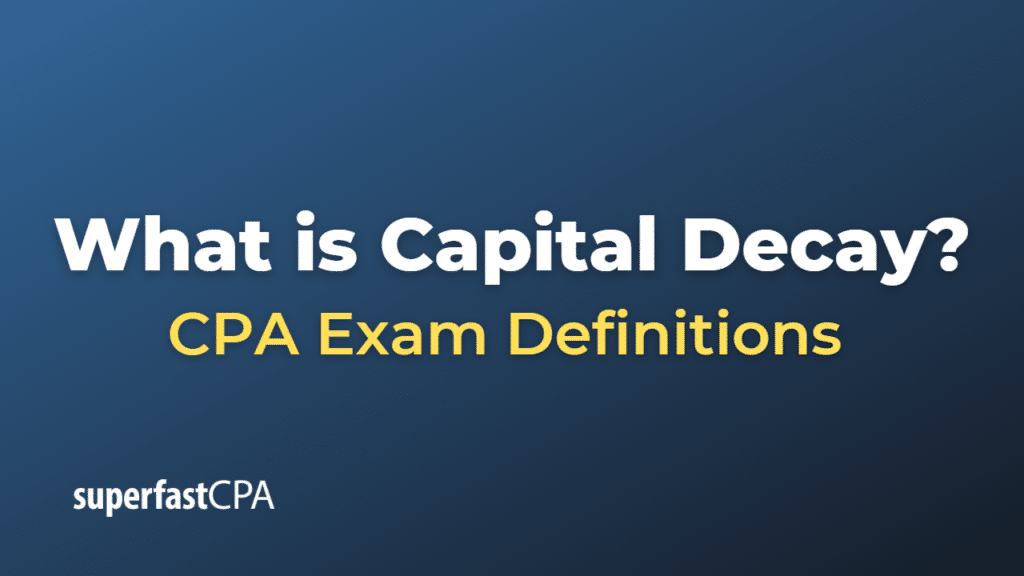Capital Decay
Capital decay, also known as capital depreciation or asset deterioration, refers to the gradual decline in the value and usefulness of a capital asset over time due to wear and tear, obsolescence, or other factors. As assets age and are used in business operations, they tend to lose their productive capacity and become less valuable, which impacts a company’s balance sheet and income statement.
Capital decay is an important concept in accounting and finance because it affects the following aspects of a business:
- Depreciation expense: To account for capital decay, businesses record depreciation expense on their income statements. Depreciation expense is a non-cash expense that represents the allocation of the cost of a capital asset over its useful life. This expense reduces a company’s taxable income, which may lower its tax liability.
- Book value: The book value of a capital asset is its original cost minus accumulated depreciation. As depreciation accumulates over time, the book value of an asset decreases, reflecting its declining value and usefulness.
- Capital expenditure (CapEx): Companies must periodically invest in new capital assets or upgrade existing ones to maintain their productive capacity and offset capital decay. These investments, known as capital expenditures, can be significant and must be carefully managed and budgeted for to ensure efficient allocation of resources.
- Asset disposal: When a capital asset reaches the end of its useful life or becomes obsolete, a company may need to dispose of it. The disposal of an asset can result in a gain or loss, depending on the difference between its net book value and the proceeds received from its sale or disposal.
Managing capital decay is essential for businesses to ensure they maintain an appropriate level of productive capacity and continue to operate efficiently. Companies must monitor the condition and performance of their capital assets, plan for necessary maintenance or replacements, and make strategic decisions about capital investments to support long-term growth and profitability.
Example of Capital Decay
Let’s consider a hypothetical example of a delivery company, “SwiftParcel,” which recently purchased a new delivery truck to expand its operations. The truck is a capital asset, and over time, it will experience capital decay due to wear and tear, aging, and potential obsolescence.
Here’s a breakdown of how capital decay impacts different aspects of SwiftParcel’s business:
- Depreciation expense: SwiftParcel uses the straight-line depreciation method to account for the truck’s capital decay. The truck cost $50,000, has an estimated useful life of 5 years, and an expected salvage value of $10,000. The annual depreciation expense would be ($50,000 – $10,000) / 5 = $8,000. This expense is recorded on SwiftParcel’s income statement, reducing its taxable income.
- Book value: The book value of the truck decreases over time as accumulated depreciation increases. At the end of the first year, the truck’s book value would be $50,000 – $8,000 = $42,000. By the end of the fifth year, the book value would be equal to the expected salvage value of $10,000.
- Capital expenditure (CapEx): As the truck ages and experiences wear and tear, SwiftParcel may need to invest in maintenance, repairs, or replacement parts to maintain its productive capacity. These investments are considered capital expenditures and must be carefully planned and budgeted for to ensure efficient resource allocation.
- Asset disposal: After 5 years, the truck may become less efficient, more expensive to maintain, or obsolete due to advances in delivery vehicle technology. SwiftParcel may decide to dispose of the truck and replace it with a newer, more efficient model. If the company sells the truck for $12,000 at the end of its useful life, it would record a gain on disposal of $2,000 ($12,000 selling price – $10,000 book value).
In this example, SwiftParcel must manage the capital decay of its delivery truck to ensure it maintains an appropriate level of productive capacity and operates efficiently. By monitoring the truck’s condition and performance, planning for maintenance and replacement costs, and making strategic decisions about capital investments, SwiftParcel can support its long-term growth and profitability.













